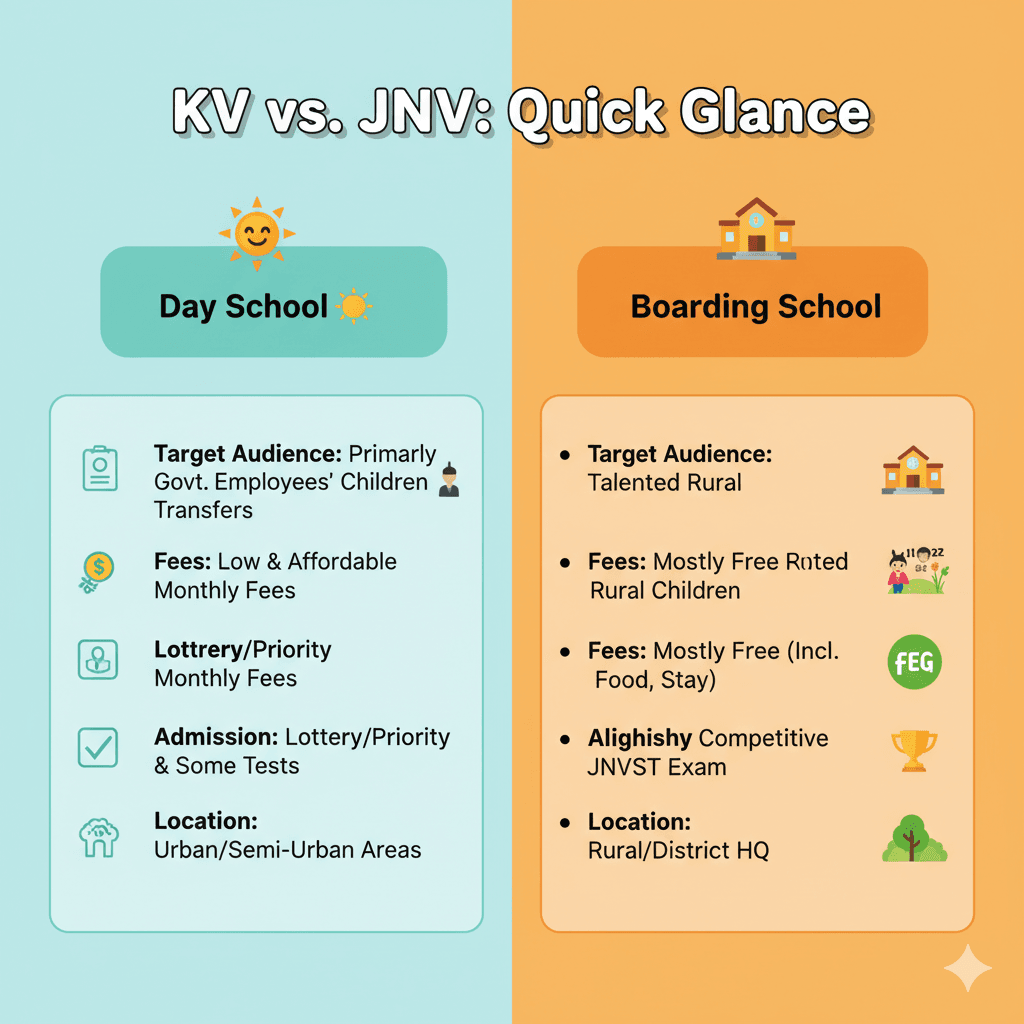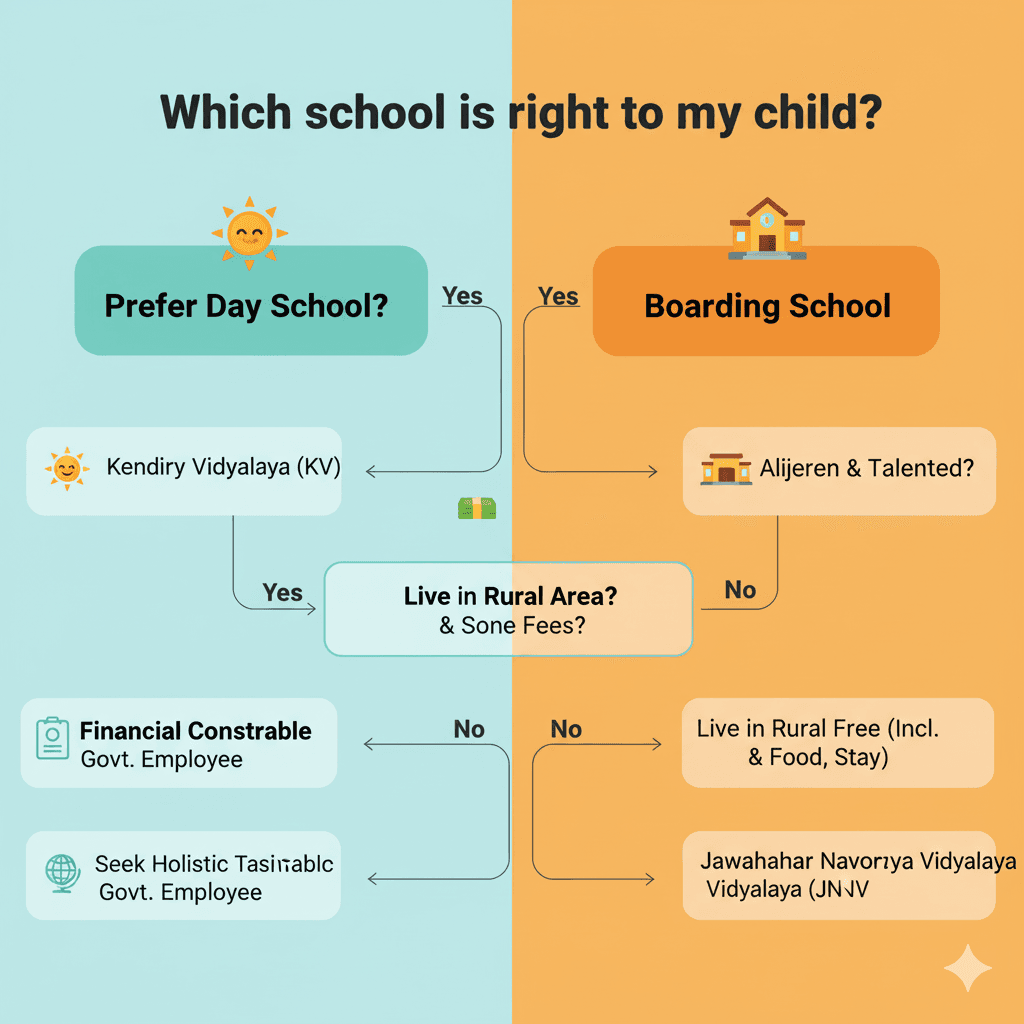Kendriya Vidyalaya vs Navodaya Vidyalaya: Choosing the Best Path for Your Child
Kendriya Vidyalaya vs Navodaya Vidyalaya
As parents in India, choosing the right educational institution for your child is a decision that shapes their future. Two prominent central government-run school systems often come to mind: Kendriya Vidyalaya (KV) and Jawahar Navodaya Vidyalaya (JNV). Both are highly respected for their quality education, but they cater to different needs and offer distinct learning environments. Let’s dive into a comprehensive comparison to help you make an informed decision.
Understanding Kendriya Vidyalaya (KV)
Kendriya Vidyalayas were established primarily to serve the educational needs of children of transferable Central Government employees, including defense and paramilitary personnel. However, seats are also available for others.
Key Features of Kendriya Vidyalayas:
- Curriculum: Follows the CBSE curriculum, known for its standardized approach and focus on academic excellence.
- Day Schooling: KVs are day schools, meaning students attend classes during the day and return home afterward.
- Geographical Spread: KVs are located in various cities and towns across India, often near government housing or defense establishments. In Lucknow, for example, you’ll find several KVs.
- Admission: Primarily based on priority categories for government employees, with a limited number of seats for general public through lottery or entrance tests for higher classes.
- Fees: Relatively low and affordable fee structure.
- Student Diversity: A mix of students from various backgrounds, though a significant portion comes from central government families.
Understanding Jawahar Navodaya Vidyalaya (JNV)
Jawahar Navodaya Vidyalayas were conceptualized to provide quality modern education to talented children, predominantly from rural areas, irrespective of their socio-economic conditions. They are residential schools.
Key Features of Jawahar Navodaya Vidyalayas:
- Curriculum: Also follows the CBSE curriculum, but with a strong emphasis on holistic development, including co-curricular activities and life skills.
- Residential Schooling: JNVs are fully residential, providing free boarding and lodging along with education. This is a significant differentiator.
- Location: Primarily located in rural areas or district headquarters, with one JNV generally established in each district. This ensures accessibility for rural talent.
- Admission: Highly competitive, based on the Jawahar Navodaya Vidyalaya Selection Test (JNVST) for admission to Class VI. Reservations are provided for rural, SC, ST, and girl students.
- Fees: Education, boarding, and lodging are completely free for most students. A nominal fee is charged from students of Class IX to XII belonging to the general category (excluding girls, SC/ST categories, and children of BPL families).
- Student Diversity: Predominantly students from rural backgrounds, fostering a unique peer learning environment.
- “Pace-setting” Institutions: JNVs aim to be “pace-setting” institutions in their respective districts, acting as a focal point for quality education.
Head-to-Head Comparison: Kendriya Vidyalaya vs Navodaya Vidyalaya

1. Type of Schooling: * KV: Day School ☀️ * JNV: Residential (Boarding) School 🏡
2. Target Audience: * KV: Children of transferable Central Govt. employees; others if seats are available. * JNV: Talented children predominantly from rural areas.
3. Admission Process: * KV: Priority-based, lottery system, some entrance tests for higher classes. * JNV: Highly competitive JNVST (entrance exam) for Class VI.
4. Fee Structure: * KV: Nominal and affordable monthly fees. * JNV: Free education, boarding, and lodging for most; nominal fee for general category boys (IX-XII).
5. Environment & Facilities: * KV: Strong academic focus, often good infrastructure. * JNV: Holistic development, 24/7 learning environment, strong community living, dedicated faculty on campus.
6. Rural vs. Urban Focus: * KV: Predominantly urban/semi-urban. * JNV: Predominantly rural, serving talent from villages.
7. Exposure: * KV: Exposure to a diverse urban/semi-urban student population. * JNV: Unique exposure to a tightly-knit community, often with rural roots, and opportunities for inter-JNV migration.

Our Conclusion:Conclusion: Kendriya Vidyalaya vs Navodaya Vidyalaya
Kendriya Vidyalaya vs Navodaya Vidyalaya- Both provide excellent academic facilities and follow the CBSE curriculum. However, JNVs, being residential schools, offer a 24/7 supervised environment, extensive co-curricular activities, sports, and a strong community living experience, which contributes significantly to holistic personality development. KVs focus more intensely on academic rigor in a day-school setting.
FAQs on Kendriya Vidyalaya vs Navodaya Vidyalaya:
What is the main difference between Kendriya Vidyalaya vs Navodaya Vidyalaya?
The main difference is that Kendriya Vidyalayas are day schools primarily for children of transferable central government employees, while Navodaya Vidyalayas are fully residential schools (boarding) for talented children, predominantly from rural areas, offering free education, food, and accommodation.
Is it harder to get admission in Kendriya Vidyalaya or Navodaya Vidyalaya?
Admission to Navodaya Vidyalaya is generally considered harder due to the highly competitive Jawahar Navodaya Vidyalaya Selection Test (JNVST) for a limited number of seats. Kendriya Vidyalaya admissions are primarily priority-based for government employees, with some lottery-based admissions for others.
Which school system Kendriya Vidyalaya vs Navodaya Vidyalaya (KV or JNV) has lower fees?
Jawahar Navodaya Vidyalayas offer largely free education, boarding, and lodging for most students (especially girls, SC/ST, and BPL categories), with a nominal fee only for general category boys in higher classes. Kendriya Vidyalayas have low and affordable monthly tuition fees, but students pay for their own boarding and other expenses as it’s a day school.
Are Navodaya Vidyalayas only for rural students?
While Navodaya Vidyalayas are primarily designed to find and nurture talent from rural areas, up to 25% of the seats can be filled by students from urban areas of the same district. However, the selection process (JNVST) is highly competitive for all.
Which school provides better facilities for overall development – Kendriya Vidyalaya vs Navodaya Vidyalaya?
Both Kendriya Vidyalayas and Jawahar Navodaya Vidyalayas offer excellent educational opportunities. Your choice will largely depend on your child’s personality, your family’s circumstances, and your long-term educational goals. If you’re a Central Government employee seeking a transferable education or prefer day schooling with an urban exposure, KV might be your pick. If you’re looking for an affordable, high-quality, residential, and holistic educational experience for a talented child, especially from a rural background, JNV stands out as an exceptional option. Consider what’s best for your child’s unique journey to make the most informed decision.
Kendriya Vidyalaya vs Navodaya Vidyalaya

